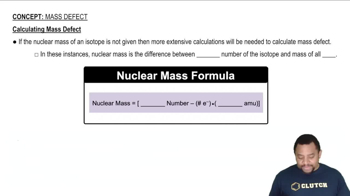Here are the essential concepts you must grasp in order to answer the question correctly.
Mass Defect
The mass defect refers to the difference between the mass of an atomic nucleus and the sum of the masses of its individual protons and neutrons. This phenomenon occurs because when nucleons (protons and neutrons) bind together to form a nucleus, some of their mass is converted into energy, as described by Einstein's equation E=mc². This energy is released during the formation of the nucleus, resulting in a lower overall mass.
Recommended video:
Binding Energy
Binding energy is the energy required to disassemble a nucleus into its individual protons and neutrons. It is a measure of the stability of the nucleus; a higher binding energy indicates a more stable nucleus. The binding energy is directly related to the mass defect, as the energy released during nucleon binding accounts for the mass that is 'lost' when the nucleus is formed.
Recommended video:
Nuclear Forces
Nuclear forces are the strong interactions that hold protons and neutrons together within the nucleus. These forces are much stronger than the electromagnetic forces that would otherwise cause protons to repel each other due to their positive charge. The strong nuclear force operates at very short ranges and is responsible for the stability of the nucleus, contributing to the mass defect and binding energy.
Recommended video:




